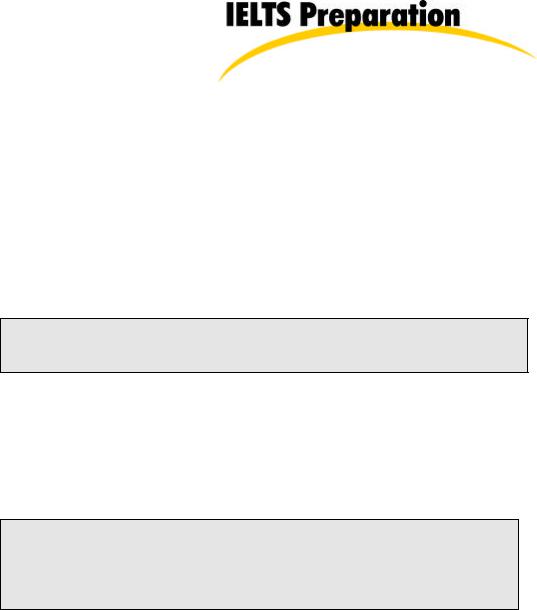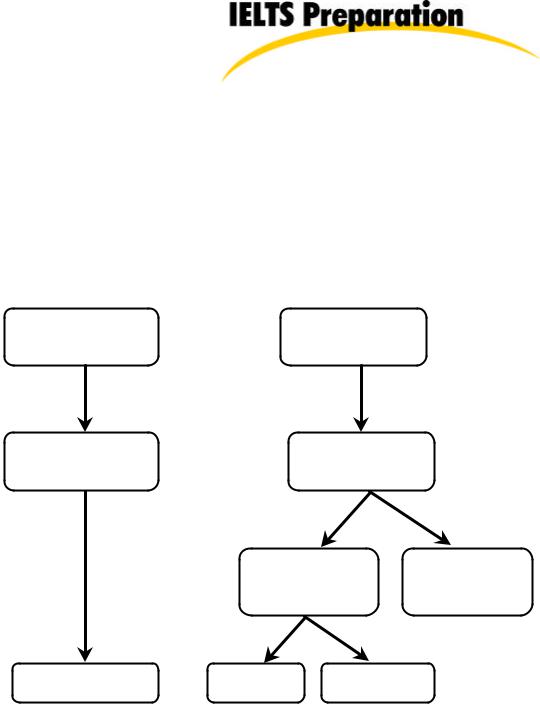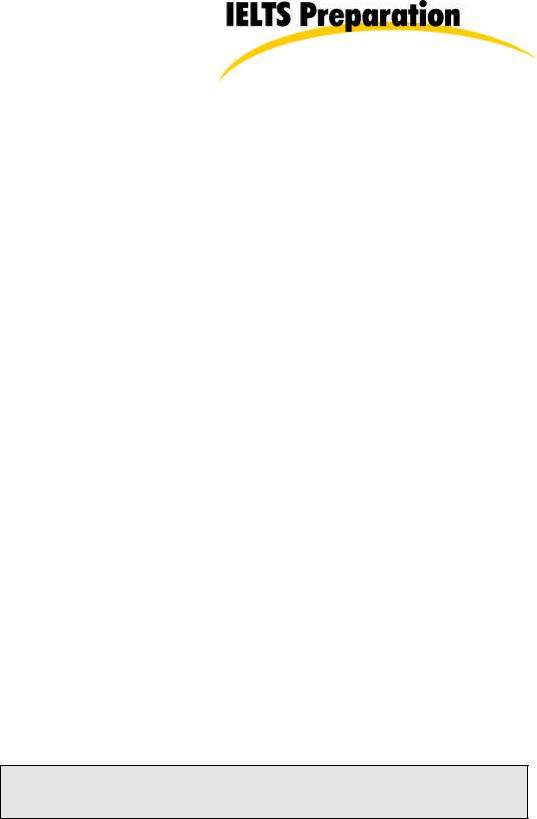
ielts_writing
.pdf
Guidelines for a good answer
Does the report have a suitable structure?
♦Does it have an introduction, body and conclusion?
♦Does it include connective words to make the writing cohesive within sentences and paragraphs?
Does the report use suitable grammar and vocabulary?
♦Does it include a variety of sentence structures?
♦Does it include a range of appropriate vocabulary?
Does the report meet the requirements of the task?
♦Does it meet the word limit requirements?
♦Does it describe the whole report adequately?
♦Does it focus on the important trends presented in the table?
Sample answers
We will now compare two sample answers, one better than the other. How well does each one follow the guidelines?
Sample answer one
The table shows how people in different age groups spent their leisure time in Someland. It can be clearly seen that the amount of leisure time available varied considerably across the age groups.
Teenagers in Someland spent 1,200 hours a year watching
TV and those in the over 70s group spent 100 hours less at 1,100. They spent 150 hours on socialising with 4 or less people compared with 200 hours at the other end of the scale. They spent 350 hours socialising with 4 or more people compared with 25 hours. The teenagers spent 450 hours on group exercise but retired people didn’t do any.
In conclusion, we can see that in Someland the teenagers and retired people prefer to spend their free time in different ways.
© 1999 Holmesglen Institute of TAFE |
31 |

Teacher's comments on sample answer one
Here is what an IELTS teacher said about the sample answer.
The report structure is clear and well organised with an introduction, body and conclusion.
The candidate uses repetitive grammatical structures and vocabulary which would bring the mark down considerably.
The tense used is not appropriate as there is no indication on the table that the figures refer to the past. Also the reader doesn’t know who is being referred to in the two sentences on socialising. The word ‘prefer’in the conclusion is inappropriate because the table does not give any indication of people’s reasons for spending their time on one activity rather than another. Someone may choose indoor rather than outdoor activities because of their health although they would prefer to go outside.
In terms of task requirements the report has serious problems. Although in writing about a table you will have the difficulty of there being too much information to put into a 150 word report, you can’t solve this problem by ignoring whole sections of the table. In this case the candidate simply compared two age levels and ignored the rest.
© 1999 Holmesglen Institute of TAFE |
32 |

Sample answer two
Here is an example of a better answer to this task. Notice how it follows the guidelines.
The table shows how people in different age groups spend their leisure time in Someland over the course of a year. It can be clearly seen that the amount of leisure time available varies considerably across the age groups and that people of different age levels have very different ways of spending their leisure time.
According to the figures, as people age in Someland their social lives reduce. Teenagers and people in their twenties spend on average 500 hours per year on socialising and 350 hours of that time is with a group of more than 4 people.
Although the total hours of socialising in their 30s, 40s, 50s and 60s is fairly constant (between 300-350), socialising with more than 4 people drops dramatically to 50 hours in the 30s and 40s age groups and only 25 from 50 years old. Group and individual exercise follow a similar pattern.
People of all ages spend a good part of their leisure time on entertainment such as TV/video viewing and cinema. In both cases, teenagers and retired people spend around twice as much time as those who are at working age. Home entertainment ranges from just over a thousand hours for teenagers and retired people and an average of 600 hours for everyone else. Cinema accounts for 100 hours of the teenagers and retired people’s leisure time and 25-50 hours for the rest.
In conclusion we can see there is a significant trend towards solitary and smaller group activities as people grow older and that teenagers and retired people spend a lot more time on entertainment than those of working age do.
© 1999 Holmesglen Institute of TAFE |
33 |

Strategies for improving your IELTS score
Report structure
Like the line graphs your report should be structured simply with an introduction, body and conclusion. Tenses should be used appropriately.
Use two standard opening sentences to introduce the table and your report. These opening sentences should make up the first paragraph. Sentence one should define what the table is about; that is, the date, location, what is being described in the graphs etc. For example:
The table shows how people in different age groups spend their leisure time in Someland over the course of a year.
Notice that the sample opening sentence does not simply copy the words used on the graphic material. Copied sentences will not be assessed by the examiner and so you waste your time including them.
Sentence two (and possibly three) might sum up the overall trend. For example:
It can be clearly seen that the amount of leisure time available varies considerably across the age groups and that people of different age levels have very different ways of spending their free time.
Notice the tense used. In this case there is no date given and so we must take the table information as being current now.
The body of the report will describe the information presented in the table in detail. You will need to decide on the most clear and logical order to present the material. Generally you will choose one of the categories given in the table; that is, the age or activity in the example task above. Your choice would depend on whether you could see the most significant trends occurring by age group or by activity. In this case distinguishing the age group is your primary concern in describing this table, and you would do this by highlighting some differences between the activity preferences of the age groups.
Ideally your report should end with one or two sentences which summarise your report or draw a relevant conclusion.
Grammar and vocabulary
You will receive a higher mark if your writing uses a range of structures and vocabulary correctly rather than a limited number.
© 1999 Holmesglen Institute of TAFE |
34 |

Selecting your information
In completing this task it is important that you cover all of the information given. However, this does not mean that you should note every detail. In tables there is invariably too much information for you to mention each figure. You will therefore need to summarise the table in meaningful segments. In other words, you will describe the significant trends in your report.
To see the trends in a table, start by finding patterns under the horizontal and vertical headings. In the sample task you would analyse the age groups and activities. We can see that at different times in their lives Someland people have more or less free time and their priorities for how they spend their free time are different. In analysing the activities we can look for which age groups spend more time on individual or group, cheap or expensive, home or outdoor, strenuous or restful activities. By describing trends in this way, we can avoid having to describe every age group across every activity.
Writing task one: processes
Task description
You will be given a diagram of a process. Your task is to describe the information given in the diagram by writing a 150 word report. You are not asked to give your opinion.
What is being tested
Task one questions asking you to describe a process rarely appear on the
IELTS test. They are different from table, graph and chart description because they test your ability to:
♦describe each important stage in the process and expand where necessary
♦link your descriptions of each stage
♦use the present simple passive
As process tasks can vary widely, it is essential that you look at a lot of examples in IELTS preparation books.
You should spend around 20 minutes on the task.
© 1999 Holmesglen Institute of TAFE |
35 |

Sample task
You should spend about 20 minutes on this task.
The flow chart below shows how national examination papers are marked in Someland.
Write a report for a university lecturer describing the information below.
You should write at least 150 words.
Reading and |
Writing test |
Listening |
collected |
Marked by an |
Marked by an |
administrator |
examiner |
Writing answer |
Marks sent to |
paper sent to |
an |
an examination |
administrator |
Collated |
Stored |
Reassessed |
Your task
Complete the Task One report exercise above. Spend only 20 minutes.
Then look at the notes and the sample answer below.
© 1999 Holmesglen Institute of TAFE |
36 |

Guidelines for a good answer
Does the report have a suitable structure?
♦Does it have an introduction, body and conclusion?
♦Does it include connective words to make the writing cohesive within sentences and paragraphs?
Does the report use suitable grammar and vocabulary?
♦Does it include a variety of sentence structures?
♦Does it include a range of appropriate vocabulary?
Does the report meet the requirements of the task?
♦Does it meet the word limit requirements?
♦Does it describe the whole process adequately?
Sample answer
The sample task given is simplified for the sake of explaining this kind of report task clearly. In a genuine test you can expect the process to be more complex.
The flow chart shows the marking procedures for national exam papers in Someland.
After the papers are collected, the Reading and Listening papers are marked by an administrator and then collated. The writing papers are treated differently. After collection, the writing papers are marked by an examiner. The marks are then sent to an administrator for collation while the exam papers are sent to an examination board. The board either stores the papers or reassesses them.
© 1999 Holmesglen Institute of TAFE |
37 |

Strategies for improving your IELTS score
Meeting the task requirements
When you begin the writing test, look at the illustration (flow chart, diagram etc) and try to work out what the important stages are, the order they occur and any obvious reasons for the order. Your report must include every stage shown in the diagram or flow chart.
When looking at the illustration, be careful to distinguish stages which happen concurrently. (A is performed at the same time as B) and others which are alternatives (either A or B is performed). The flow chart given in the Sample Task demonstrates this problem. Look at the stages for the writing test. In the second stage we can see that the writing paper is marked by an examiner. It is then sent to the examination board while at the same time the marks are sent to an administrator. These events occur concurrently. In the final stage, the papers are either stored or reassessed.
These events are alternatives.
It may happen that the diagram does not make much sense to you at first glance. Look for a starting point and follow through the stages in your mind before beginning to write. If it’s still not making sense, then go on to Task Two but make sure that you give yourself 20 minutes to complete the report before the end of the writing test time. It often happens that our brains can sort problems out for us even when we are focusing on something else.
Report structure
Like the line graphs, your report should be structured simply with an introduction, body and conclusion. Tenses should be used appropriately.
Use one standard opening sentence to introduce the report. This opening sentence will make up the first paragraph. You should state simply what the process is. For example:
The flow chart shows the marking procedures for national exam papers in Someland.
Notice that the sample opening sentence does not simply copy the words used in the task instructions. Copied sentences will not be assessed by the examiner and so you waste your time including them.
The body of the report will describe the process in a logical order.
A conclusion will generally not be necessary in this kind of report.
© 1999 Holmesglen Institute of TAFE |
38 |

Grammar and vocabulary
You will receive a higher mark if your writing uses a range of structures and vocabulary correctly rather than a limited number.
If the flow chart is simple and linear then you may be able to link the stages together by simply using some of the following transition signals.
To begin with
First of all
First
Secondly, thirdly, etc
Then
Next
After that
Finally
If the process is more complex, as in the example above, then you may need to also use these words
Alternatively
Otherwise
In addition
At the same time
Concurrently
Using the present simple passive
The passive is associated with an impersonal formal style. It is often used in notices, announcements and describing processes. Compare the following sentences:
Active: The examiner marks the test paper
Passive: The test paper is marked
The two sentences have the same meaning but the emphasis is different. In the active sentence we are more interested in the person or thing doing the action (the agent).
In the passive sentence we are more interested in the person or thing affected by the action. If we want to mention the agent we use by:
The test paper is marked by the examiner
But often the agent is not important.
© 1999 Holmesglen Institute of TAFE |
39 |

The passive is not another way of expressing the same sentence in the active. We choose the active or passive depending on what we are more interested in. In the first sentence we are more interested in the examiner. In the second sentence we are more interested in the test paper.
Subject |
|
is / are |
past participle |
(by agent) |
The test paper |
is |
|
marked |
(by the |
|
|
|
|
examiner) |
|
|
|
|
|
© 1999 Holmesglen Institute of TAFE |
40 |
